As an herbalist, I love to work close to nature. The great thing is that in exploring your own backyard you can usually find edible plants to harvest. The challenge is to look at these plants not as weeds, but as nutritious vegetables.
Many of these edible weeds contain good amounts of iron, calcium, and vitamins A, C, and K. They also contain antioxidants, which the body needs to stay healthy. Yes, many of those weeds and invasives in your yard are actually highly nutritious and often very tasty. They can boost your vitamins and minerals, and even help you save on your grocery bill.
Let’s explore some of the most common edible weeds you will find in the Southern Finger Lakes Region of New York State.
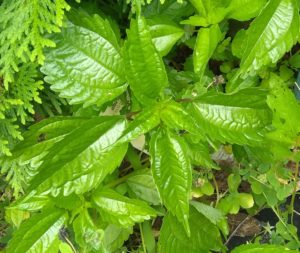 Clearweed (Pilea pumila) This is a new discovery in my yard this year. Clearweed is related to nettles (Urtica dioica), but doesn’t “sting”. The stems are somewhat translucent, which lead to its name. The leaves are oval in shape with saw tooth edges. From personal experience, I can say that the flavor is mild, and not unlike spinach. It steams or sautées nicely, and goes well with an omelet. According to renowned herbalist Henriette Kress, clearweed may be helpful with inflammation when used as a poultice or salve. (1) Nettles tend to be a good source of vitamin A and calcium, and even have some protein, so it would be likely that clearweed would be similar (although I have not been able to find specific information regarding this).
Clearweed (Pilea pumila) This is a new discovery in my yard this year. Clearweed is related to nettles (Urtica dioica), but doesn’t “sting”. The stems are somewhat translucent, which lead to its name. The leaves are oval in shape with saw tooth edges. From personal experience, I can say that the flavor is mild, and not unlike spinach. It steams or sautées nicely, and goes well with an omelet. According to renowned herbalist Henriette Kress, clearweed may be helpful with inflammation when used as a poultice or salve. (1) Nettles tend to be a good source of vitamin A and calcium, and even have some protein, so it would be likely that clearweed would be similar (although I have not been able to find specific information regarding this).
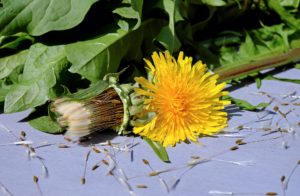 Dandelion (Taraxacum spp) Everyone is familiar with this “weed”, but most people don’t realize it was brought to the Americas by European settlers. The various legends include wanting it for its medicinal properties, as well as for the cheerful yellow flowers that reminded them of home. The entire plant is edible – the flower, leaves, and roots. They are one of the most nutritious plants available, being rich in vitamins and minerals. The greens are especially high in vitamins A & K, contain a good amount of vitamin C, are high in fiber and low calorie. (2) They are less bitter if you pick the young leaves before they flower. You can use the flowers for making tea, wine, or beer, and they also make a lovely healing salve. The flower buds, picked very early, can be pickled and used like capers (Here is a great recipe!).
Dandelion (Taraxacum spp) Everyone is familiar with this “weed”, but most people don’t realize it was brought to the Americas by European settlers. The various legends include wanting it for its medicinal properties, as well as for the cheerful yellow flowers that reminded them of home. The entire plant is edible – the flower, leaves, and roots. They are one of the most nutritious plants available, being rich in vitamins and minerals. The greens are especially high in vitamins A & K, contain a good amount of vitamin C, are high in fiber and low calorie. (2) They are less bitter if you pick the young leaves before they flower. You can use the flowers for making tea, wine, or beer, and they also make a lovely healing salve. The flower buds, picked very early, can be pickled and used like capers (Here is a great recipe!).
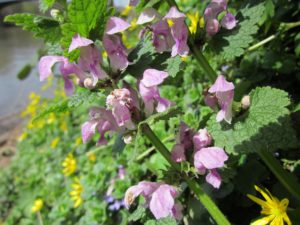 Henbit (Lamium amplexicaule) This weed is related to deadnettles (Lamium album & Lamium purpureum) and is another in the nettle family. It’s cheerful purple flowers grow in clusters around the stems and are edible, along with the leaves. Personally, I avoid the flower base unless it has just started to bloom because it can get rather tough. The flavor is fairly mild when the plant is young, so it’s best to take the tips and younger parts. It can be cooked or used as a tea. Cooked, it goes well in a stir fry or soup, where it also adds fiber, iron, and other minerals. As a tea, it can be beneficial for fevers (as a diaphoretic and febrifuge). (3)
Henbit (Lamium amplexicaule) This weed is related to deadnettles (Lamium album & Lamium purpureum) and is another in the nettle family. It’s cheerful purple flowers grow in clusters around the stems and are edible, along with the leaves. Personally, I avoid the flower base unless it has just started to bloom because it can get rather tough. The flavor is fairly mild when the plant is young, so it’s best to take the tips and younger parts. It can be cooked or used as a tea. Cooked, it goes well in a stir fry or soup, where it also adds fiber, iron, and other minerals. As a tea, it can be beneficial for fevers (as a diaphoretic and febrifuge). (3)
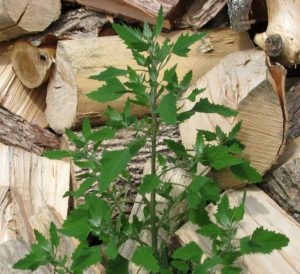 Lambsquarters (Chenopodium album) When I went exploring for information on this particular plant, I discovered that it is a relative of buckwheat, amaranth, and quinoa. This makes it part of the family of “pseudocereals”. (4) While the seeds of lambsquarters aren’t normally used to make flour or cooked like rice, the leaves and flowers are edible. The mild flavor of this plant goes well in a salad, as a sautéed vegetable, or in soups and stews. Lambsquarters can provide protein, iron, calcium, and several B vitamins. (5) This weed is also useful as it reintroduces nutrients back into the soil (similar to sunflowers and hemp), there it is a beneficial weed for soil reclamation. (6)
Lambsquarters (Chenopodium album) When I went exploring for information on this particular plant, I discovered that it is a relative of buckwheat, amaranth, and quinoa. This makes it part of the family of “pseudocereals”. (4) While the seeds of lambsquarters aren’t normally used to make flour or cooked like rice, the leaves and flowers are edible. The mild flavor of this plant goes well in a salad, as a sautéed vegetable, or in soups and stews. Lambsquarters can provide protein, iron, calcium, and several B vitamins. (5) This weed is also useful as it reintroduces nutrients back into the soil (similar to sunflowers and hemp), there it is a beneficial weed for soil reclamation. (6)
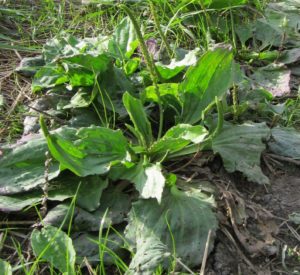 Plantain (Plantago spp) Another naturalized plant, brought to the Americas by Europeans. This wonder of weeds, however, is one of the most versatile out there. It can be used as a food source, used medicinally, and even used to wrap food (yes, I’ve made “plantain tamales”!). Medicinally, it can be taken both internally and used externally at the same time. The leaves can make a refreshing tea, which (when strained carefully) can be used as a wash for skin or eye problems. The seeds can be added to homemade bread, or even ground up into smoothies. (6) Be careful, though, as the seeds, in particular, tend to be laxative (Yes, that “Psyllium” you buy at the store comes from the Plantago psyllium!). If you love using kale or lettuce to make a wrap, plantain leaves do the job admirably, as well!
Plantain (Plantago spp) Another naturalized plant, brought to the Americas by Europeans. This wonder of weeds, however, is one of the most versatile out there. It can be used as a food source, used medicinally, and even used to wrap food (yes, I’ve made “plantain tamales”!). Medicinally, it can be taken both internally and used externally at the same time. The leaves can make a refreshing tea, which (when strained carefully) can be used as a wash for skin or eye problems. The seeds can be added to homemade bread, or even ground up into smoothies. (6) Be careful, though, as the seeds, in particular, tend to be laxative (Yes, that “Psyllium” you buy at the store comes from the Plantago psyllium!). If you love using kale or lettuce to make a wrap, plantain leaves do the job admirably, as well!
Pesto & Smoothies
One of my favorite summertime condiments is a good pesto. And the five weeds listed above do the job amazingly well! Any of the weeds listed below also go well in a “Weed Pesto”, so be adventurous and make a variety! The recipe I use as a base is called “Planty Kim’s Wild Greens Pesto”, and you can find the recipe here. I use a bit of culinary license when making mine because chickweed (Stellaria media) isn’t always available.
And if you’re into smoothies, any of the herbs mentioned here will boost the nutritional value, and most will do it without being overly bitter or strong. Lambsquarters, in particular, go very nicely with some frozen mango, flaxseed, chia seed, plantain, and plain (or vanilla) yogurt. Again, be adventurous, and see what you like.
*One thing to keep in mind is that several of these plants are high in oxalates, which can affect the liver. Be mindful of the quantity used (including over time), especially if you have problems with the liver, kidney, or suffer from gout.
If you’re curious about other edibles you may find, check these out: bitter dock (Rumex obtusifolius), black mustard (Brassica nigra), chickweed (Stellaria media), creeping Charlie (Glechoma hederaceae), garlic mustard (Alliaria petiolate), purple deadnettle (Lamium purpureum), red clover (Trifolium pretense), self heal (Prunella vulgaris), and yellow wood sorrel (Oxalis stricta).

Resources:
- https://www.henriettes-herb.com/eclectic/kings/urtica.html
- https://healthyeating.sfgate.com/health-benefits-eating-dandelion-greens-4433.html
- https://www.ediblewildfood.com/henbit.aspx
- https://www.healthline.com/nutrition/foods/buckwheat
- https://www.melindamyers.com/audio-video/melindas-garden-moment-audio-tips/problems-pests-weeds/edible-and-nutritious-lambsquarter-chenopodium-album
- https://www.ediblewildfood.com/lambs-quarters.aspx
- https://www.ediblewildfood.com/broadleaf-plantain.aspx
- https://sustainablegrub.wordpress.com/2013/03/17/chickweed-pesto-2/


